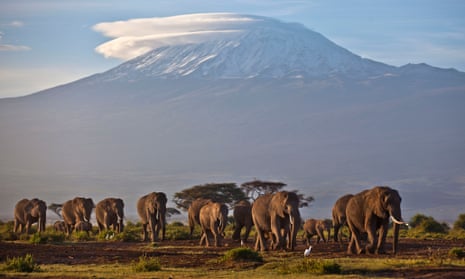Tanzania has emerged as the epicentre of Africa’s elephant poaching crisis after a government census revealed it had lost a “catastrophic” 60% of its elephants in just five years.
The results will pile pressure on a government that has been heavily criticised for its inability to stop a flood of poached ivory being stripped from its national parks.
Tanzania’s elephant population is one of the continent’s largest. But data, released on Monday by the Tanzanian government, showed that between 2009 and 2014 the number dropped from 109,051 to 43,330. When an annual birth rate of 5% is taken into account the number of dead is 85,181.
The census reveals a loss to Africa’s elephants far greater than declines reported in Mozambique last week.
The country’s minister for natural resources and tourism Lazaro Nyalandu said the situation was “unimpressive”.
“It is evident that elephant population in Tanzania has reached unprecedented low level,” he said. Tanzania’s wildlife rangers may be trained as a paramilitary as part of a government action plan to combat poaching, which Nyalandu identified as the “probable reason” for the decline.
John Scanlon, the secretary general of Cites, the UN authority that oversees the trade in endangered species, said: “These figures reinforce our grave concerns about the scale of poaching of elephants in Tanzania for their ivory, and the smuggling routes through Dar es Salaam and neighbouring ports.”
Steven Broad, executive director of wildlife trade monitor Traffic, said: “It is incredible that poaching on such an industrial scale has not been identified and addressed before now.”
Traffic said the numbers were “catastrophic” but said they aligned with their observations of ivory flows from the country. Since 2009, at least 45 tonnes have reached the international black market from Tanzania, making it Africa’s largest source of poached ivory.
The losses were not uniform, and were at their worst in the Ruaha–Rungwa, Malagarasi-Muyovosi and Selous-Mikumi ecosystems which all lost more than two-thirds of their elephants. In these reserves the “carcass ratio”, a number used to assess the death rates within populations, indicated elephants were dying at four times the natural rate.
There were more than 34,000 elephants in Ruaha–Rungwa in 2009. This declined to around 20,000 in 2013 before a massive collapse to just 8,000 in 2014 . Nyalandu said the decline in Ruaha–Rungwa was “alarming”.
WWF’s global species programme director Carlos Drews said the disappearance of so many elephants from Ruaha–Rungwa could only be explained by the involvement of the international crime gangs who have industrialised the killing of Africa’s megafauna.
“The slaughter of thousands of elephants in Ruaha–Rungwa clearly points to the involvement of international organised crime, which is compounded by corruption and weak enforcement capacity in Tanzania – and to the urgent need to scale up efforts to tackle the poaching epidemic before the area’s remaining elephant herds are destroyed,” he said.
In the Selous reserve, which has previously been identified as a poaching hotspot, the numbers dropped from almost 45,000 to around 15,000. Last year Unesco added Selous to its World Heritage in Danger list.

Comments (…)
Sign in or create your Guardian account to join the discussion